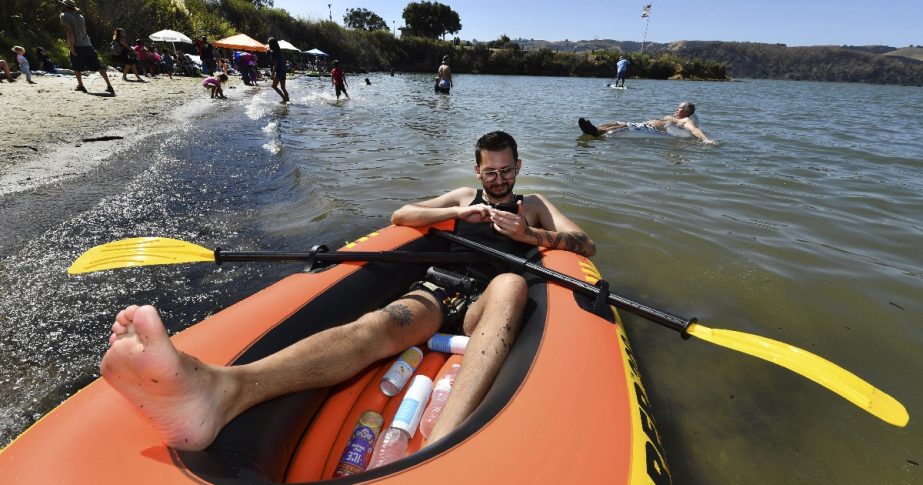
LOS ANGELES, Sept 6 (AP/UNB) — California will face its highest chance of blackouts this year as a brutal heat wave continues to blanket the state with triple-digit heat, officials warned Monday.
As people crank up their air conditioners, the state forecast record levels of energy use that could exceed supply Monday evening, said Elliot Mainzer, president of California Independent System Operators, which runs the state’s electrical grid.
The state could fall 2,000 to 4,000 megawatts of electricity short of its power supply, which represents as much as 10% of normal demand, he said.
State energy officials said the electrical load on Tuesday potentially could hit 51,000 watts, the highest demand ever seen in California.
CAISO issued a Flex Alert call for voluntary conservation between 4 p.m. and 10 p.m. on Monday and for 4 p.m. to 10 p.m. Tuesday, making seven alerts in as many days. Consumers were urged to keep air conditioners at 78 degrees (25.5 degrees C) or higher during the period and avoiding using major appliances such as ovens and dishwashers.
The efforts have worked to keep the lights on “but we have now entered the most intense phase of this heat wave” that could last into the week, and two to three times the level of conservation will be needed from people and businesses, Mainzer said.
During the day, California’s energy grid runs on a mix of mostly solar and natural gas, as well as some imports of power from other states. But solar power begins to fall off during the late afternoon and into the evening, which is the hottest time of day in some parts of the state.
Meanwhile, some of the aging natural gas plants that California relies on for backup power aren’t as reliable in hot weather.
CAISO also issued a Stage 2 Energy Emergency Alert from 6:30 p.m. to 8 p.m. Monday. The second of three emergency alert stages means taking emergency energy-saving measures “such as tapping backup generators, buying more power from other states and using so-called demand response programs,” according to a CAISO website.
Stage 3 would be rolling blackouts, where the energy load is reduced by switching off the power for (hopefully) short periods around the state.
Southern California Edison urged its customers to conserve energy through 10 p.m. tonight, the company said.
The state has additional energy capacity for protection at the moment “but blackouts, rolling, rotating outages are a possibility today,” Mainzer said, calling additional conservation “absolutely essential.”

Several hundred thousand Californians lost power in rolling blackouts in August 2020 amid hot weather. The state avoided a similar scenario last summer. Gov. Gavin Newsom on Friday signed legislation potentially allowing the state’s last remaining nuclear plant to stay open beyond its planned 2025 closure in order to ensure more power for the energy grid.
The National Weather Service predicted highs between 100 and 115 degrees (37.7 C and 46.1 C) across inland areas of the state with 80s to 90s (above 26.6 C and below 37.2 C) closer to the coast. Nighttime won’t bring much relief, with many places seeing lows in the 80s or even 90s (above 26.6 C and below 37.2 C).
Ironically, unsettled weather also brought the chance of thunderstorms over Southern California and into the Sierra Nevada, with a few isolated areas of rain but nothing widespread. The storms also could produce lightning, forecasters said, which can spark wildfires.
The scorching heat and low humidity were further drying out brush and adding to the challenges of battling wildfires, said Anale Burlew, a deputy chief with the California Department of Forestry and Fire Protection.
Some 4,400 firefighters were battling 14 large fires around the
South of the Oregon state line, the Mill Fire was 40% contained on Monday after killing two people, injuring others and destroying at least 88 homes and other buildings since it erupted last week, Burlew said.
The fire killed two women, ages 66 and 73, who were found inside the city limits of Weed on Friday after the fire broke out, the Siskyou County Sheriff’s Office announced Monday. Their names and details of their deaths weren’t immediately released.
In Southern California, the Fairview Fire that started Monday in Hemet quickly spread to at least 500 acres, firefighters said. Multiple residential structures were on fire.
Last week, seven firefighters were sent to the hospital for heat-related problems but Burlew said the extreme weather wasn’t likely to disrupt current firefighting efforts.
The fire had burned 6.6 square miles (17.25 square kilometers) of grass, brush and timber but it wasn’t expected to grow and many evacuations had been lifted.
However a few miles away, the Mountain Fire was 16.6 square miles (43 square kilometers), only 10% contained and winds could renew its growth east in steep terrain, fire officials said at a Monday morning briefing. No buildings had burned.
Scientists say climate change has made the West warmer and drier over the last three decades and will continue to make weather more extreme and wildfires more frequent and destructive.

